This!


Two great tastes that taste great together.
When I bought the Goruck GR0, I wanted a sturdy daypack with enough space for a (1, 2, 3) day trip. I figured that I would use it to carry my Fujifilm X-E1 as well, but didn't give much thought to how the camera would rest in the backpack. My solution for carrying the X-E1 in the GR0 looked like this:
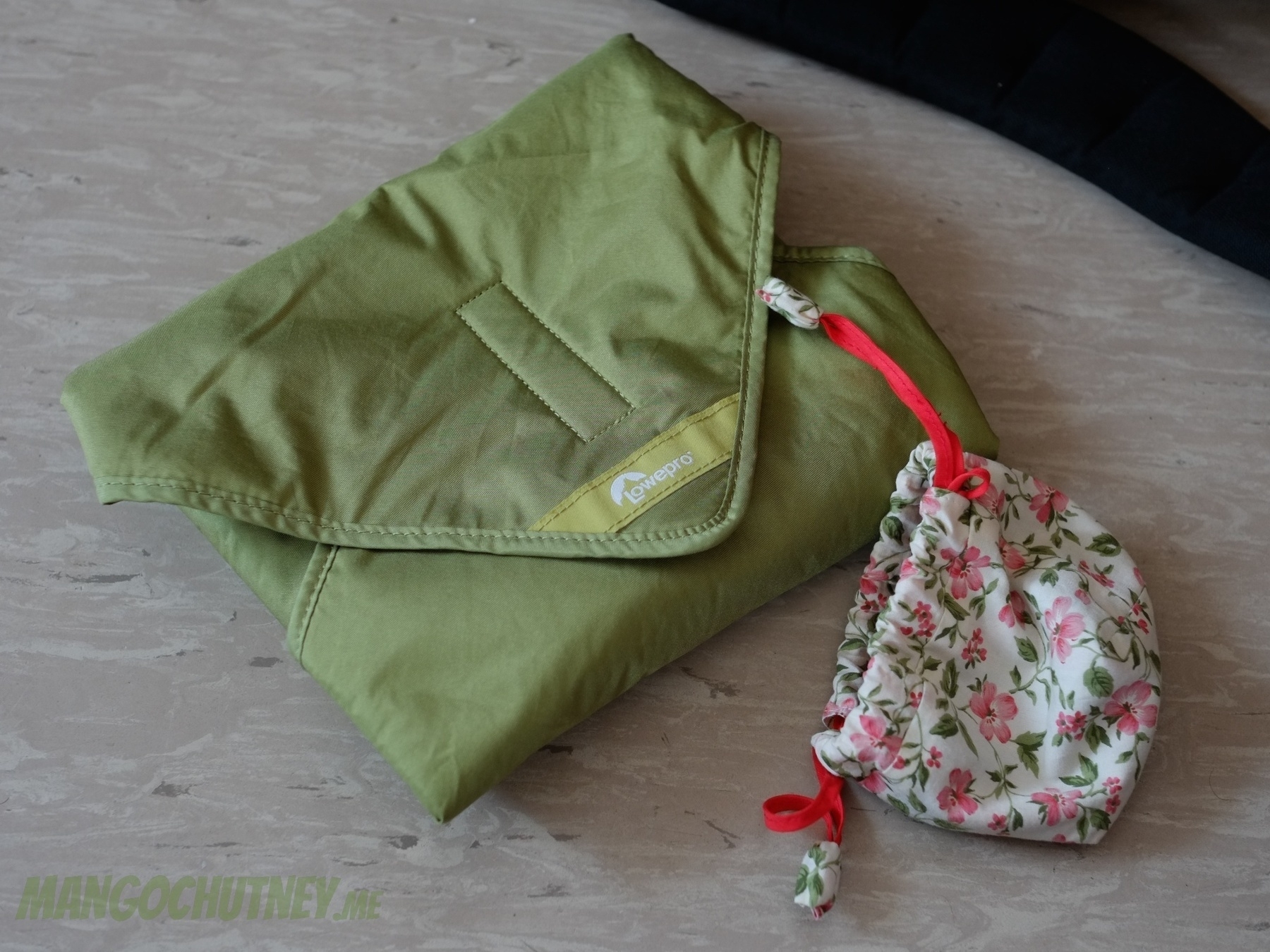
A cushioned LowePro wrapping cloth and a simple cotton string pouch for the batteries, SD cards and a few other small items. This was bad for several reasons, but the most annoying one was my gear shifting positions in the backpack, forcing me to hunt for it when I wanted to retreive the camera or a fresh battery.
I started looking for a different solution and stumbled across great ideas like using the insert from a Bilingham Hadley Pro inside the GR0, as shown by Jon Adair. Three things stopped me from going this route:
I kept looking, trying out a few other camera pouches and inserts, like Crumpler's Banana Bowl and solutions by LowePro and less well-known companies. The issues I had with the Banana Bowl were pretty much paradigmatic for all the other products I found and/or tried:
I had almost given up and started thinking about ways to modify a Goruck GR2 Field Pocket as a camera bag insert and even considered making my own padded Cordura 500 den, MOLLE webbing-equipped insert (I'm not completely inept with fabrics and a sewing machine).
Then I stumbled across a company called f-stop and their Micro Small ICU (Internal Camera Unit). This company was entirely unknown to me but apparently they make really good gear, as reviews like this one show. Scouring their site for measurements and volumes (because the above insert was still a bit too big for my needs) I found the Harney Pouch.
The dimensions (W × H × D) are 28 cm × 18 cm × 10 cm (11" × 7.1" × 3.9") with a volume of about 5 l.
It was a perfect fit for the GR0 (11.5" × 17.5" × 5.5") or in fact any GR-series bag, because all of them are about 11.5" wide.
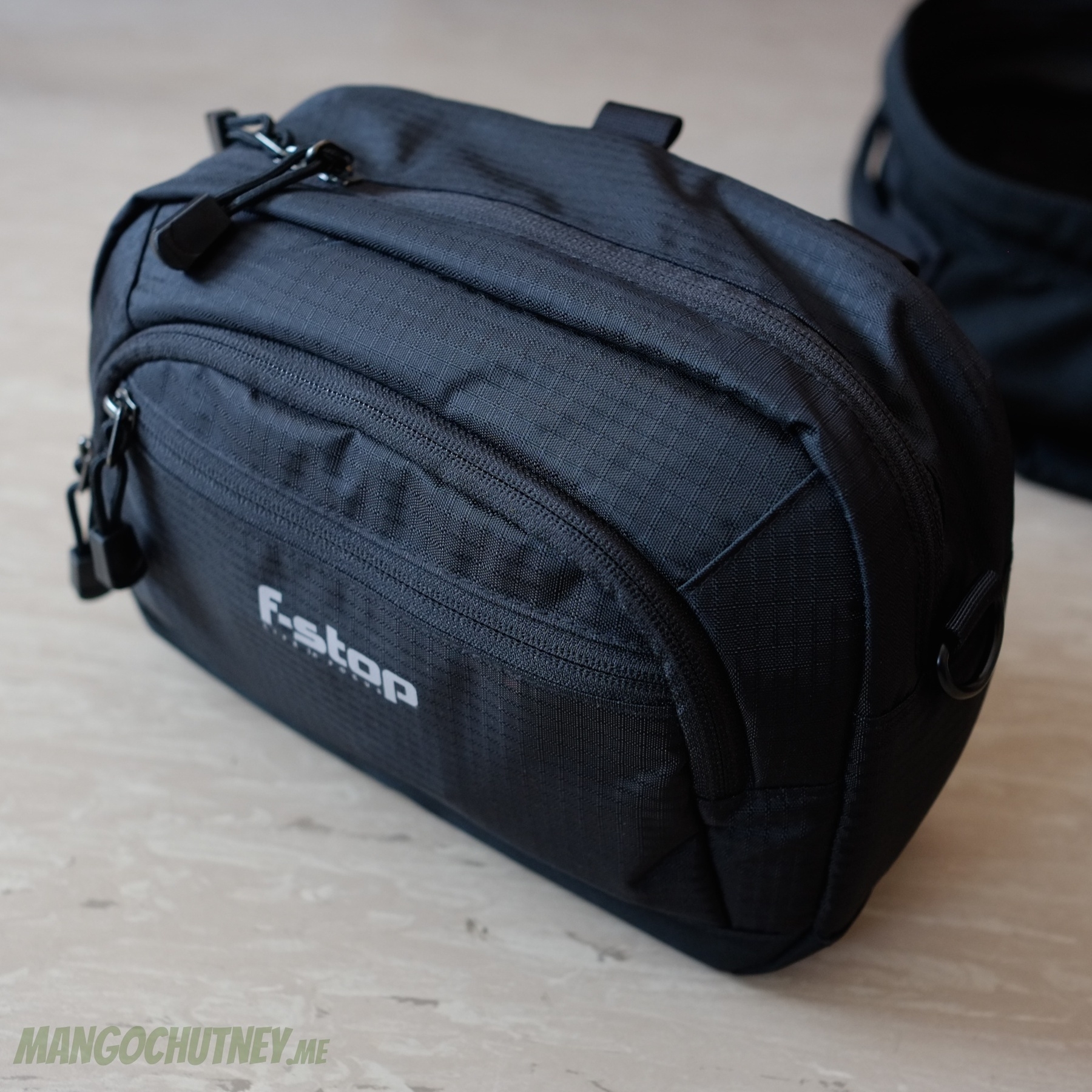
The Harney Pouch's outer fabric is 330 den Double Ripstop Nylon, it has a foam-cushioned and customisable main compartment, and two smaller and flatter compartments on the front (for less bulky accessories like batteries, memory cards, lens caps, and straps). It also comes with a light and comfortable shoulder strap, enabling use as a standalone bag. The bottom is reinforced and coated with a non-slip rubber.
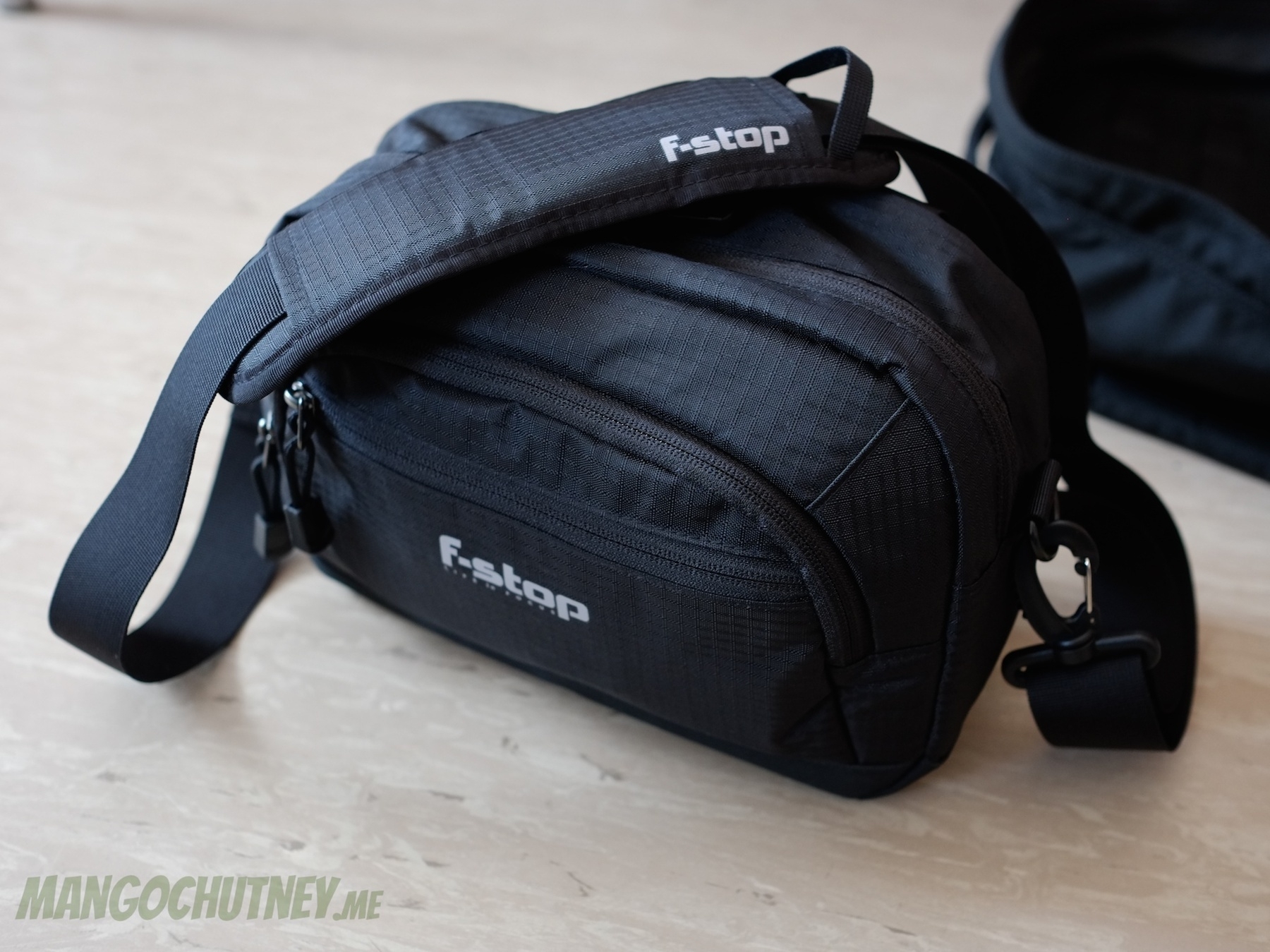
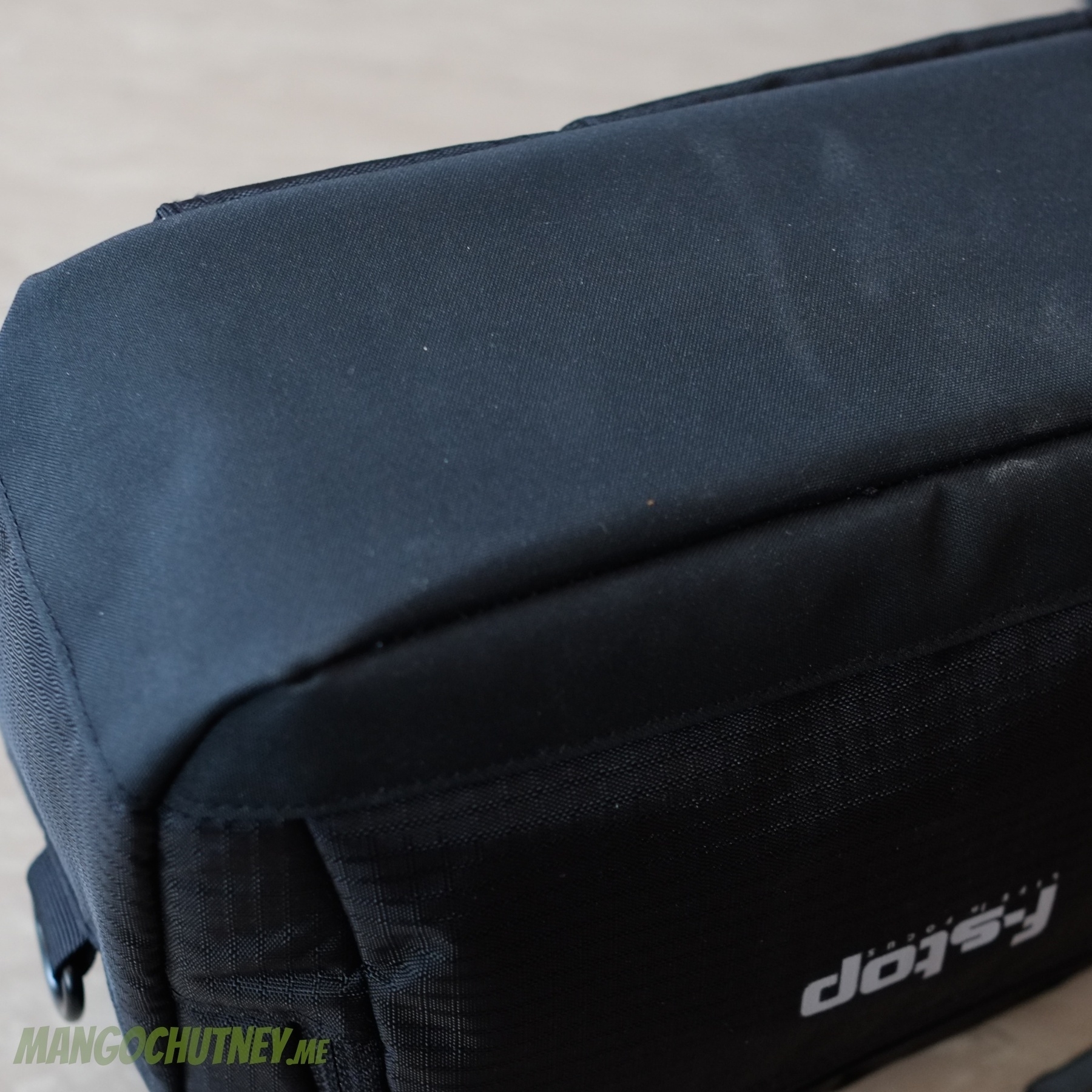
The real kicker however is the backside of the pouch. Originally meant as an accessory to one of f-stops other carrying systems, it has straps on the back that are compatible with MOLLE webbing:
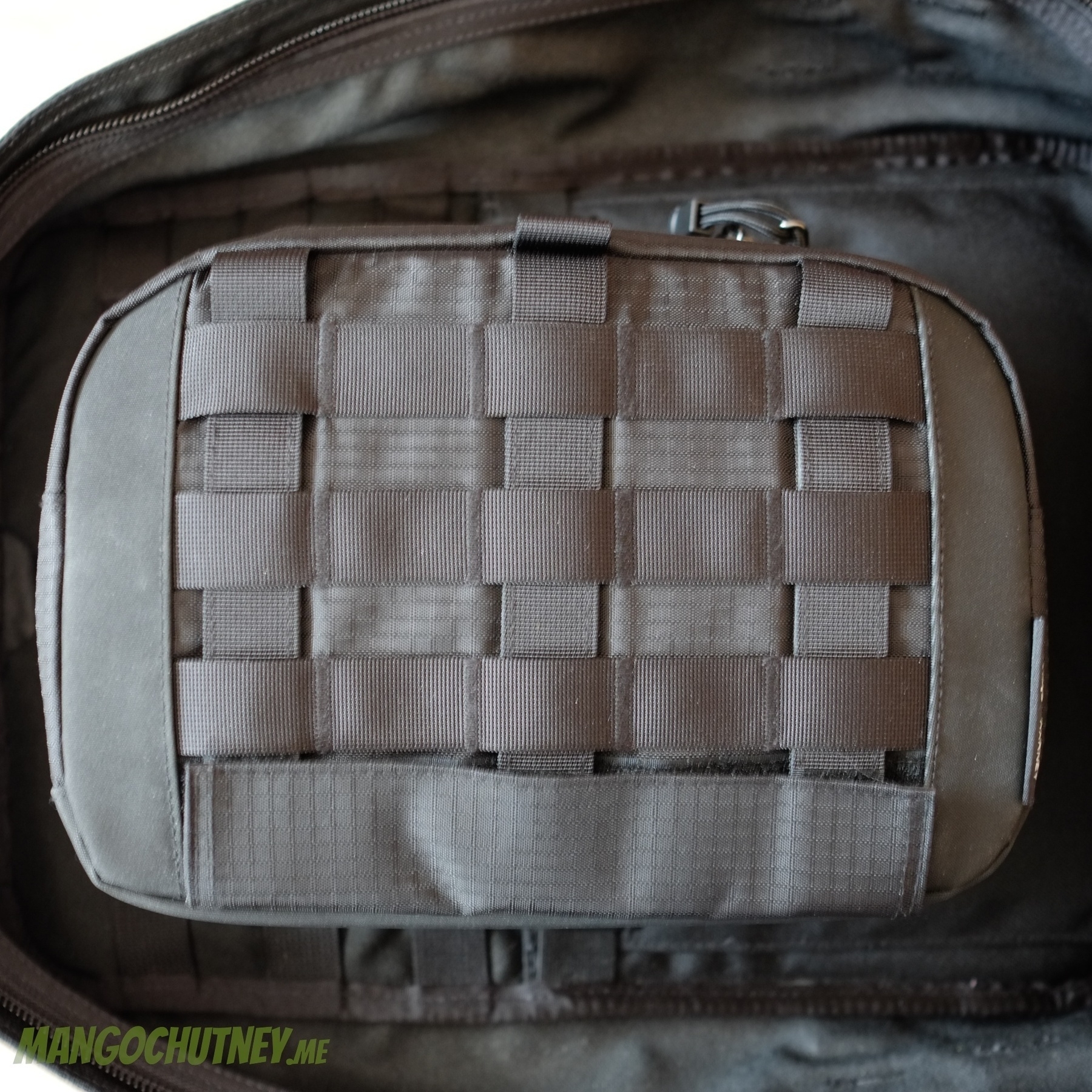
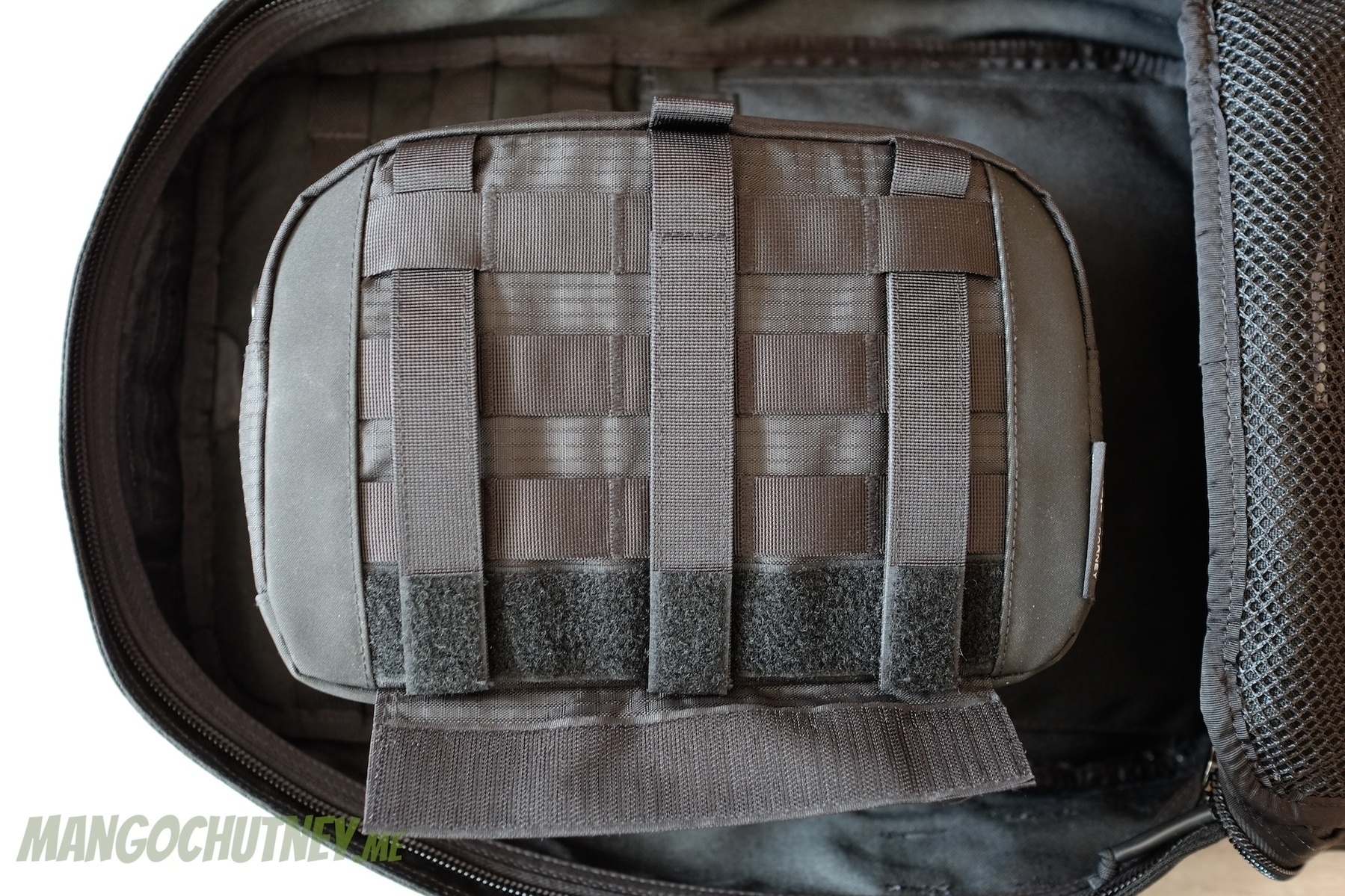
It fits the GR0's internal MOLLE webbing almost perfectly. There are only two things to observe when attaching it to the GR0:
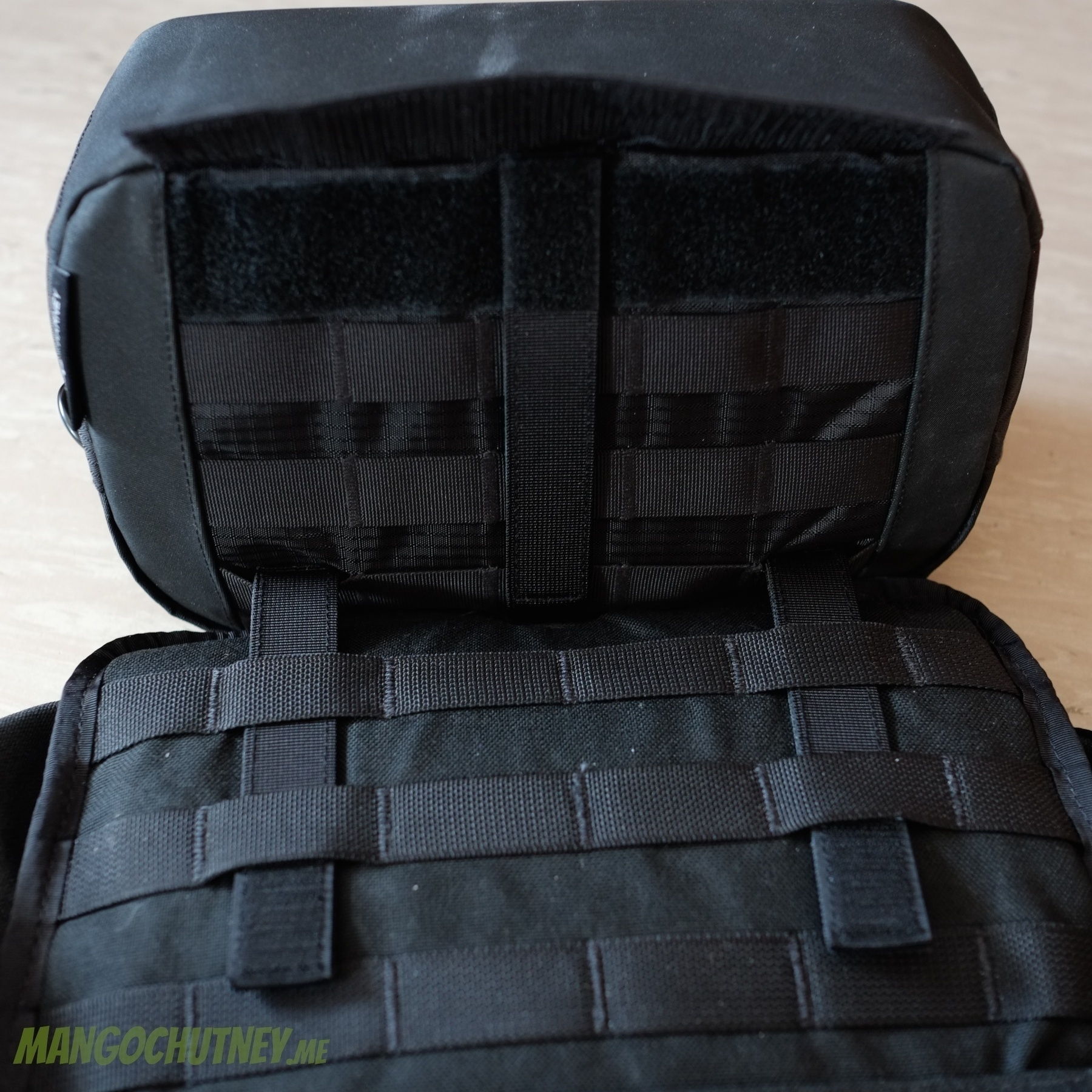
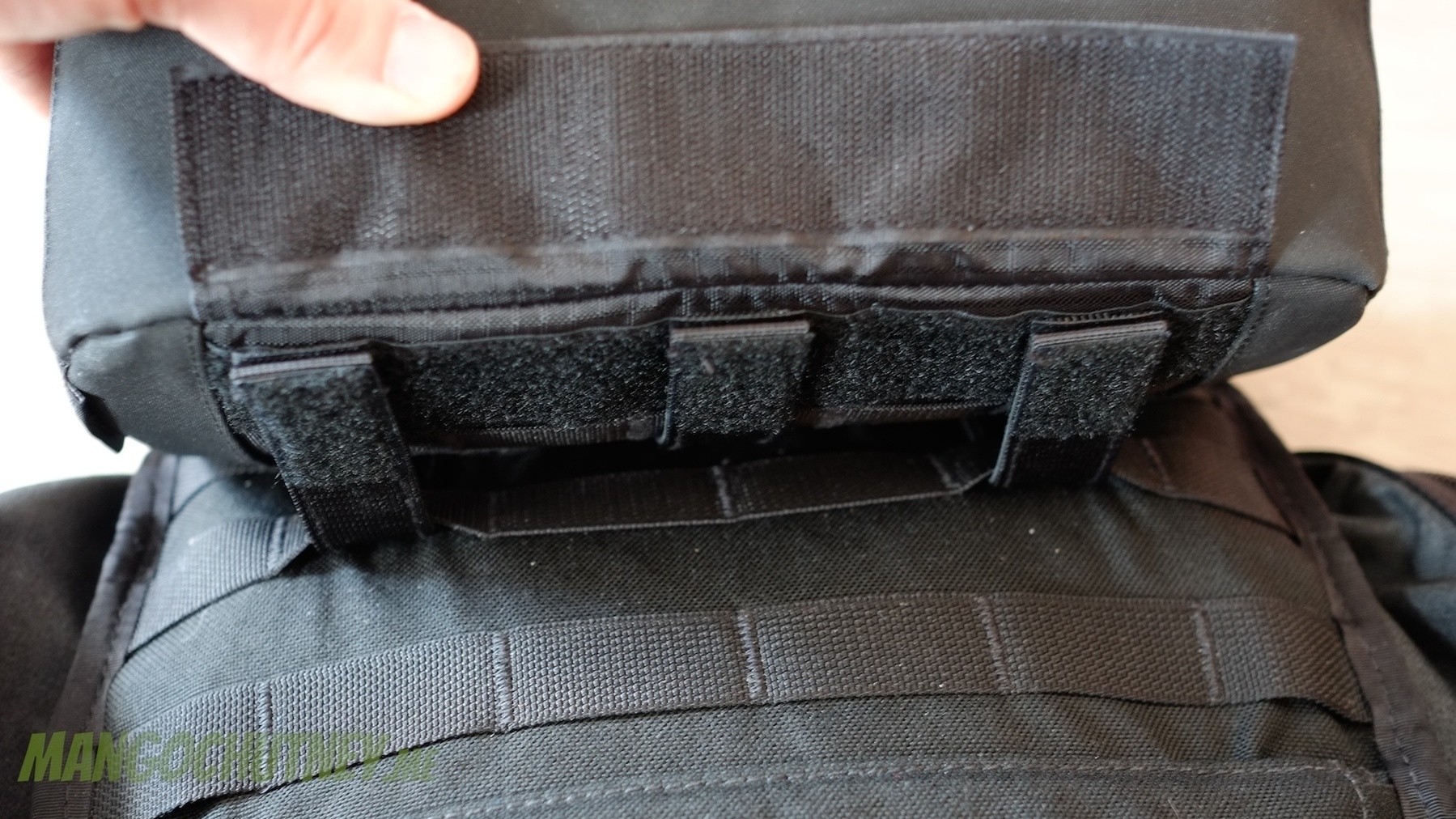
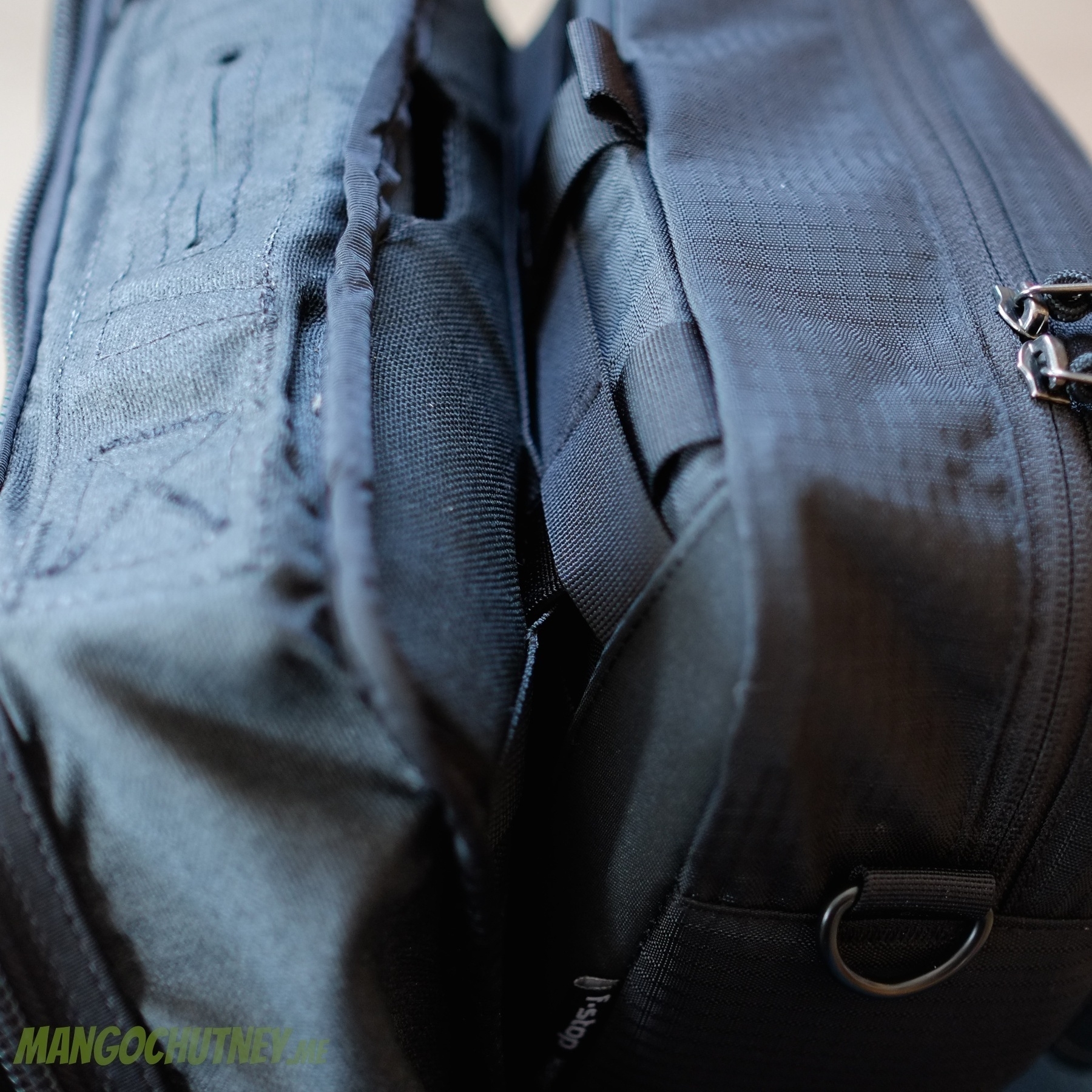
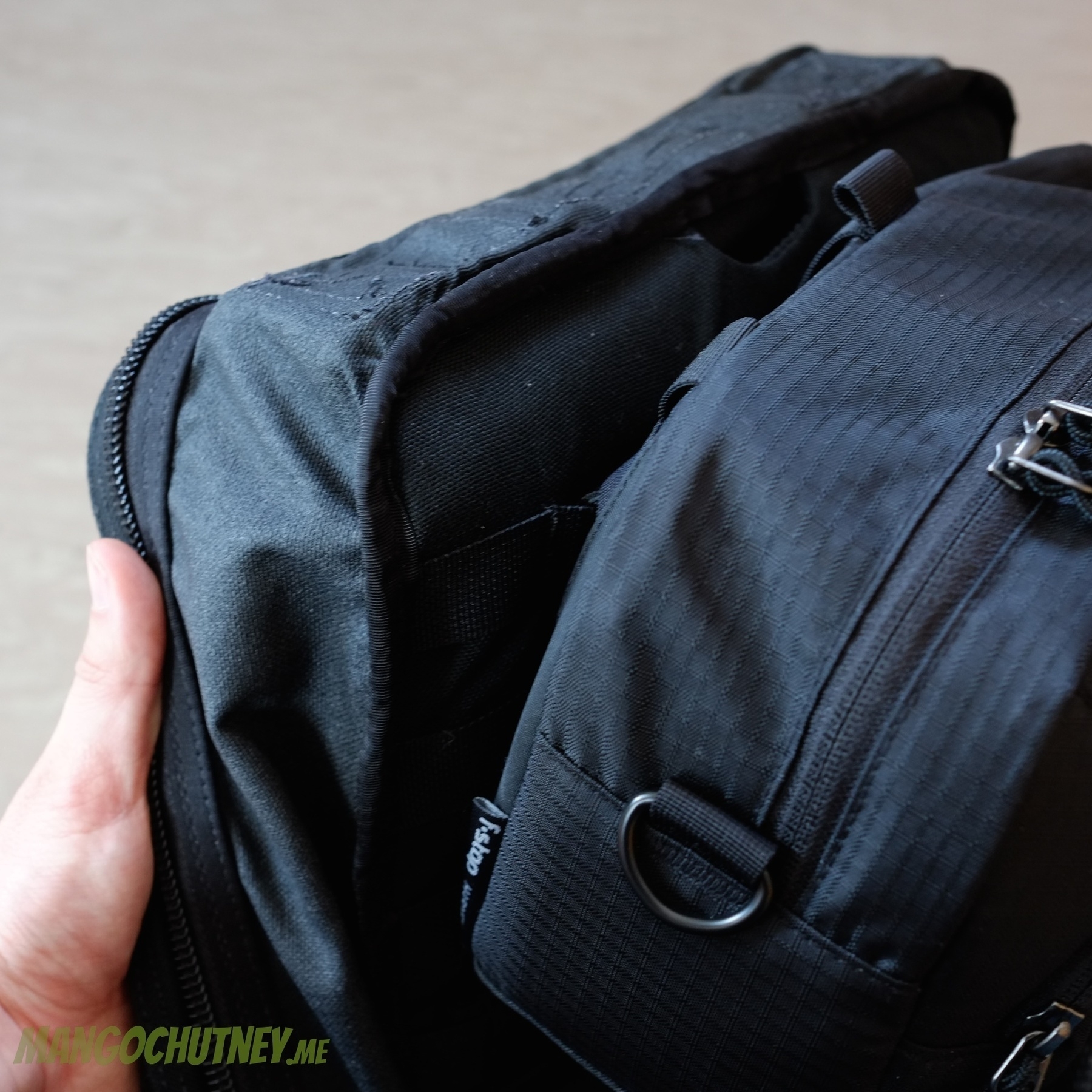
Attaching the Harney Pouch the regular way (by pulling the vertical straps through the GR0's topmost horizontal row first) will result in gap at the top of the pack, which can't really be utilised.
The method described above places the Harney Pouch perfectly at the top of the Goruck, making it very easily accessible while not wasting any space.
Size-wise the Harney Pouch really hits a sweet spot for me. I'm a photography beginner and don't have much gear — I also don't plan to build up a massive arsenal of lenses and cameras. Here's what's inside the Harney Pouch:
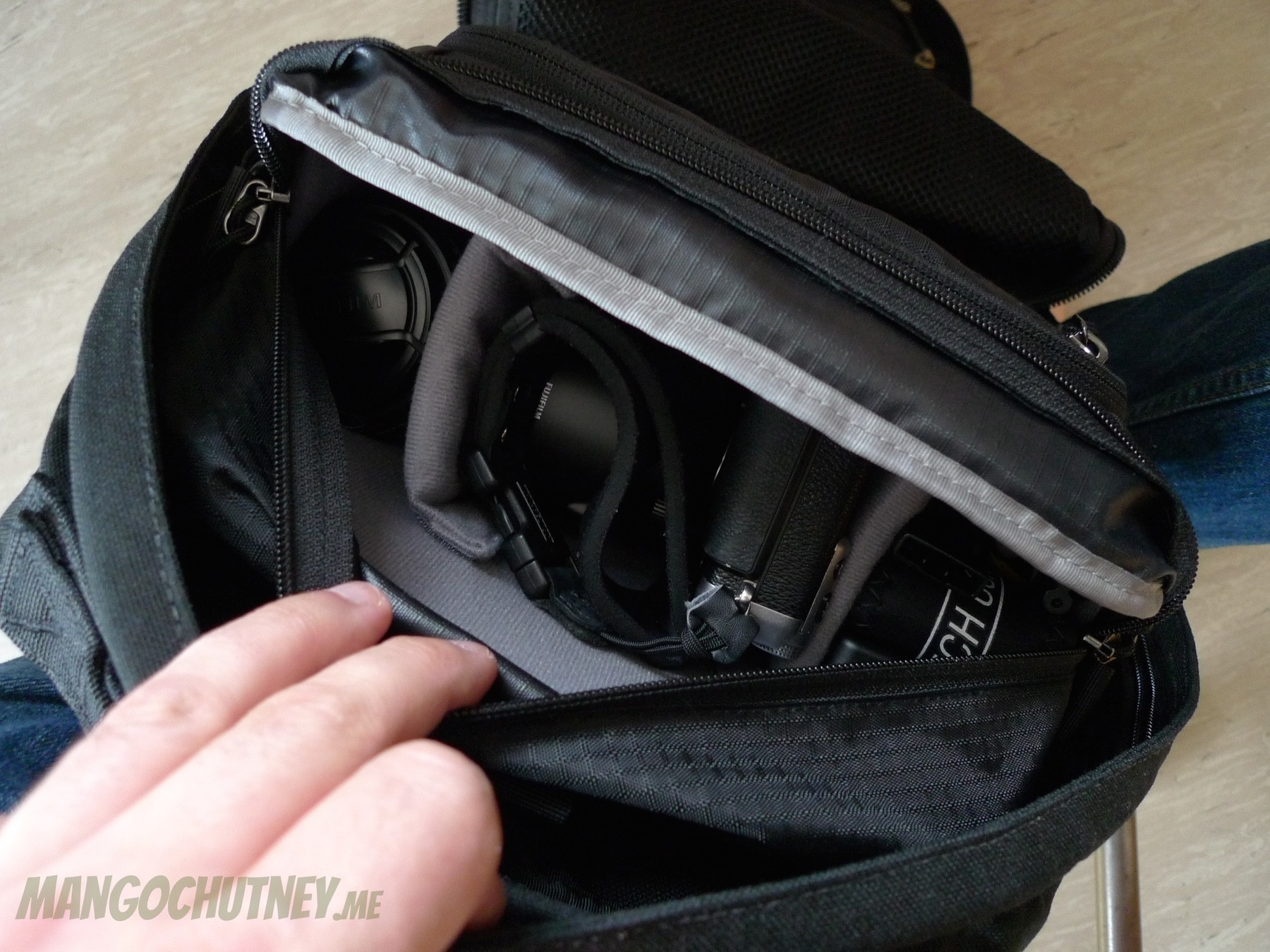
To the left there's the Fujifilm Fujinon XF 18-55mm F2.8-4 R LM OIS with the lens hood. The X-E1 rests in the middle, with the XF 23mm F1.4 R including the lens hood and an OP/TECH 'SLR Wrist Strap' attached. On the right there's the shoulder pad of my OP/TECH 'Utility Strap – Sling' (which I reviewed here), the charger for the X-E1's batteries and the charger cable.
In the frontmost compartment I store spare batteries and the memory cards and the middle compartment houses parts of the OP/TECH strap and some accessories for it as well as a spare lens cleaning cloth.
When I'm certain that I won't be using the camera during transit, I also store a rocket blower in the Harney Pouch.
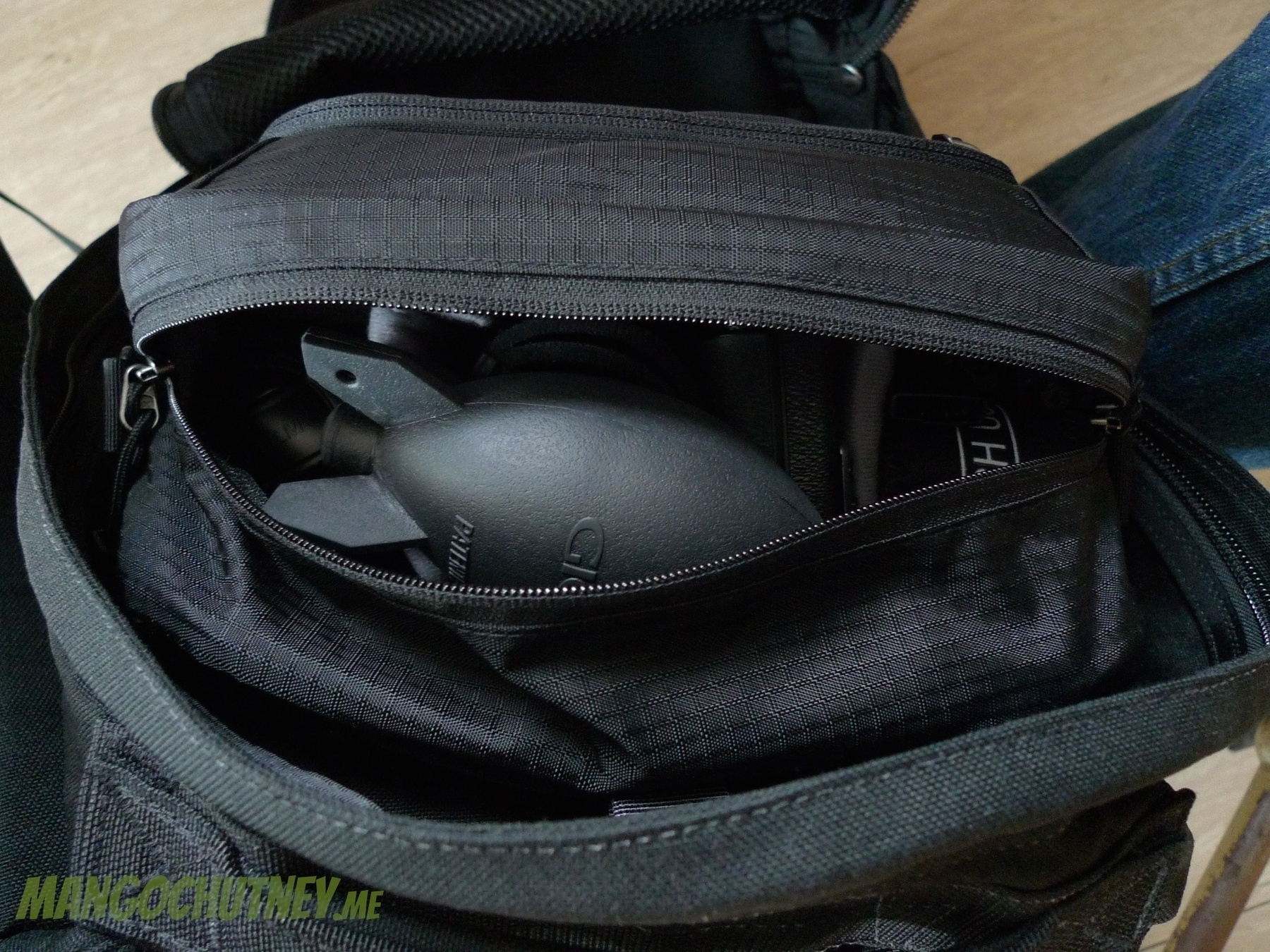
As far as I can tell, there's enough room in this camera bag to accomodate a mid-sized SLR with one additional lens or an even smaller mirrorless interchangeable lens camera (like the Sony Alpha 5000) with two additional lenses and some accessories.
When attached to the GR0, it effectively eats about 1/3 of the usuable volume (5 of 21 available litres). It also makes the ruck rather top-heavy, causing it to collapse into itself when not fully packed. However, this isn't necessarily much of an issue: when trying to retreive something from the Harney Pouch while out and about, I usually stand the GR0 up straight, leaning it against one of my legs, or hoist it over one shoulder in front of my chest.
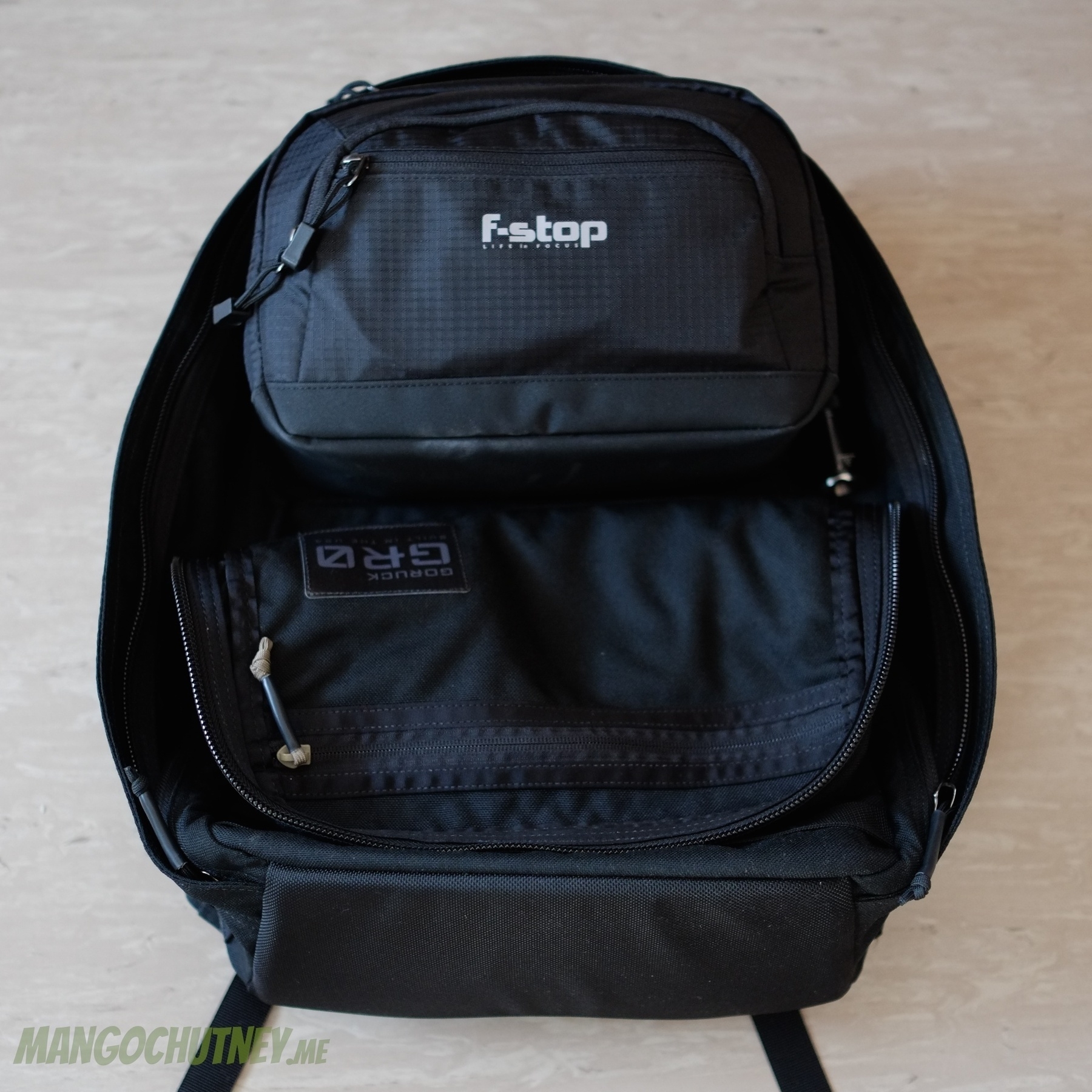
This is what the GR0 looks like when I'm going somewhere without my laptop:
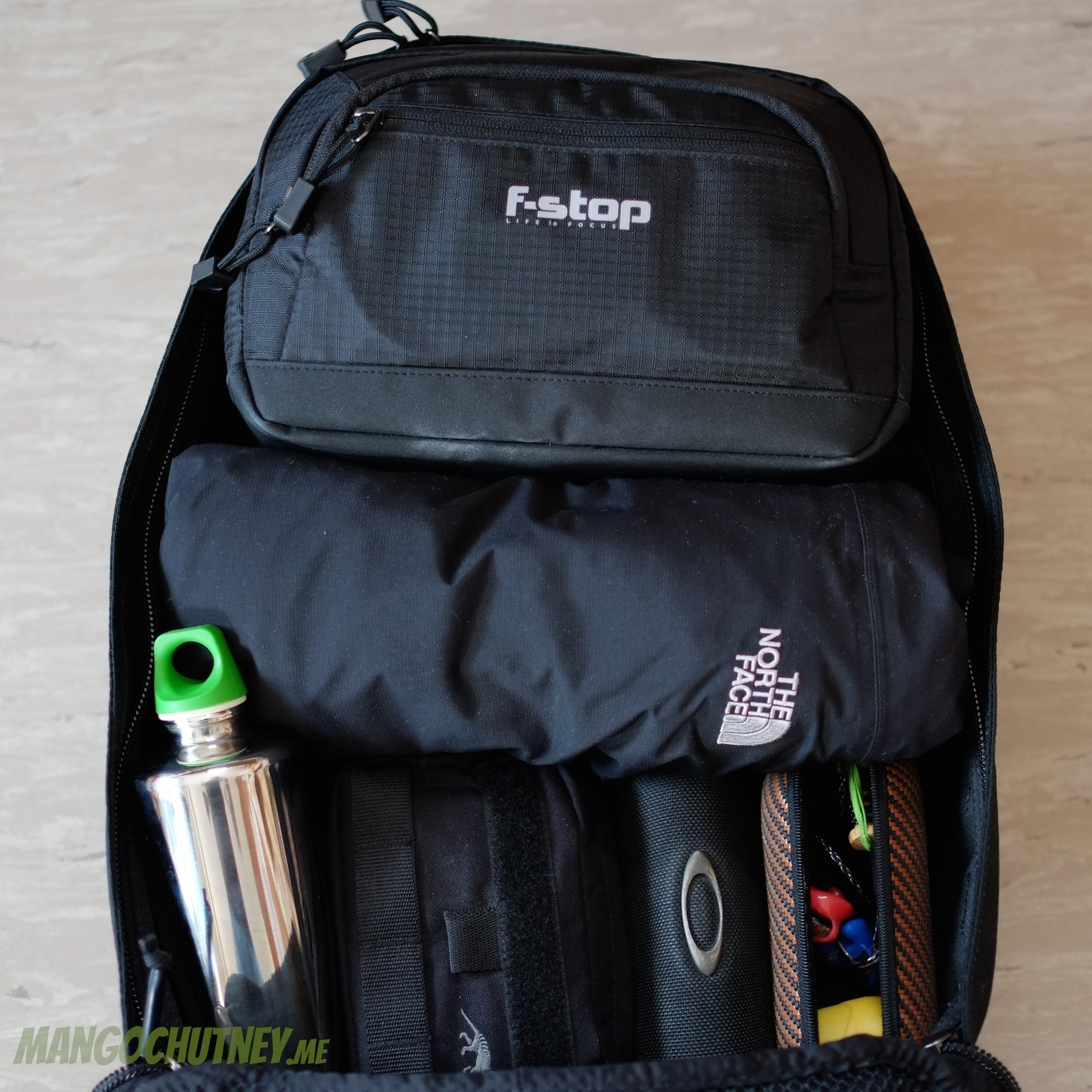
For reference: Light waterproof jacket, 0.5 l stainless steel bottle, Tasmanian Tiger TacPouch (used as an organiser for smaller items), specs case for my sunglasses, and a specs case that I use for my earphones.
If I take the laptop with me, it's stored in the appropriate compartment in the back while its accessories and backup hard drive are organised in a medium-sized Cocoon Grid-It! organiser and stored in the main compartment. With all of the above already in the Goruck GR0, there's still enough space for some food and a light fleece sweater.
In larger Goruck backpacks the volume of the Harney Pouch will have a comparatively smaller impact on the available space of the backpack. And if I really need the internal space of the GR0, I can also attach the Harney Pouch to the outside of the GR0.
In conclusion I can say that it's hard to imagine a more fitting solution to carry my camera gear within the Goruck GR0 than the f-stop Harney Pouch. Inside the backpack it gives me quick access to my camera gear while staying out of the way when I pack my stuff. Outside the GR0 it is a sturdy, well-made, versatile, spacious (enough), and comfortable camera bag. Considering what it does, $ 75.- (I paid € 55.-) isn't too much to ask.
I use Apple devices most of the time, but in recent months I had to use Windows 8.1 as well, both for my thesis and my job. The way I'm using Windows 8.1 is in a virtual machine on my 2013 13" MacBook Pro with Retina Display. I also have a second MacBook Pro (an old one from 2008) that runs Windows 7 in Boot Camp).
Windows 8 can be a great OS and an incredibly frustrating one to work with. The positives are that it feels very lightweight and lean compared to Windows 7 and Vista; it has a fairly small footprint in terms of storage requirements and resource consumption; it's fairly secure; I actually like the Start Screen, but then I also like Launchpad in OS X; the flat design is visually pleasing and well-implemented.
The one thing that I can complain about, regularly drives me bonkers. It's a schizophrenic OS that doesn't really know what it wants to be:
I've said this before and I'll say it again: Microsoft should've taken a page out of Apple's book and gone with Windows RT for tablets and Windows 8 for laptops and desktop PCs. Proper optimisation and strict UI requirements for Windows RT applications would've made this entire mess avoidable and would've benefitted not only the users but also Microsoft in the long run.
But unfortunately the c-level at Microsoft was too timid to let go of the past and backwards compatibility, too afraid of what their partners and businesses would say.
In Germany there's a word for what Microsoft was trying to accomplish with Windows 8: They tried to create an 'eierlegende Wollmilchsau'.
Loosely translated it means 'jack of all trades', strictly translated something like 'egg-laying wool-milk-pig', and we all know that those don't exist — or shouldn't exist, depending on your stance on genetic experimentation ;)
The Surface Pro 3
I'm actually excited about this device and I look forward to trying one. It won't get me to switch from my MacBook Pro with Retina Display and iPhone, but from everything I've seen and read so far, Microsoft managed to produce a device with exceptional build quality, listened to what users looked for in a Tablet PC, and improved on the already good Surface Pro 2.
I had the chance to try the Surface Pro 2 a couple of times and found it to be the single most enjoyable Windows 8 tablet to date (my points of comparison are tablets by ASUS, ACER, and HP) and it set the bar very high for third-party manufacturers.
I'd have no qualms recommending the Surface Pro 2 or the new Surface Pro 3 to someone who wants a Windows tablet. They're certainly better than anything by ASUS, ACER, HP, DELL, and the rest right now. The only exception to this is Lenovo; while they, too, produce a lot of crap, the Thinkpad T43x series of laptops and the Thinkpad X23x series of convertibles are genuinely good devices.
… but I need it in my life.

Source: NHOJ

Found on: House of Grindlebone
When I bought my first good camera a few months ago one of the big questions was how I wanted to carry and use it. Before the Fujifilm X-E1 I used a Panasonic DMC-LX3 and always carried it on a wrist strap. The X-E1 is substantially bigger and heavier and I wasn't sure whether to get a wrist strap as well, or rather a neck strap or one of those new-fangled sling straps.
During my search I was introduced to many products by many companies: Crumpler, Gordy, BlackRapid, SunSniper, LowePro, Artisan & Artist, Joby, Clik Elite, Luma Labs, and many more.
The raw utility, customisability, and the quality varied as heavily as the prices and the more expensive products usually weren't the best or nicest looking ones.
The general consensus regarding neck and sling straps seemed to be, that tripod-mounted solutions came loose more often than one would expect and didn't inspire confidence.
One company that was often mentioned in passing was OP/TECH, a U.S. company that has apparently been around for years. A few quick checks at the major online retailers revealed that its products were generally well-liked, sturdy, and reasonably priced.
Out of curiosity I purchased the Utility Strap - Sling, and the SLR Wrist Strap from OP/TECH. (The price for both items and a few additional connectors was lower than the price of one BlackRapid sling strap.)
At first I was a bit anxious because they use quick disconnects and like many people I've had the occasional bad experience with these kinds of connectors from other companies. These, however, seem to be exceptionally sturdy and well-made, locking in place with a satisfying CLICK and no wiggle room.
It turns out that my anxiety was unwarranted. I've been using the two straps for about three months now, during hikes, walking around town, a few (business) trips and pretty much everywhere I took my camera to and at no point did I fear that the straps or the couplings would come loose on their own.
I can't say that the OP/TECH gear is the nicest looking solution, but it's certainly the most versatile and functional I've seen (having tried products from BlackRapid and Crumpler in the meantime). I can quickly change between having the X-E1 dangling from my wrist, to having it on the sling strap, to attaching it to one of the shoulder pads of my Goruck GR0 using a spare OP/TECH connector and a carabiner.
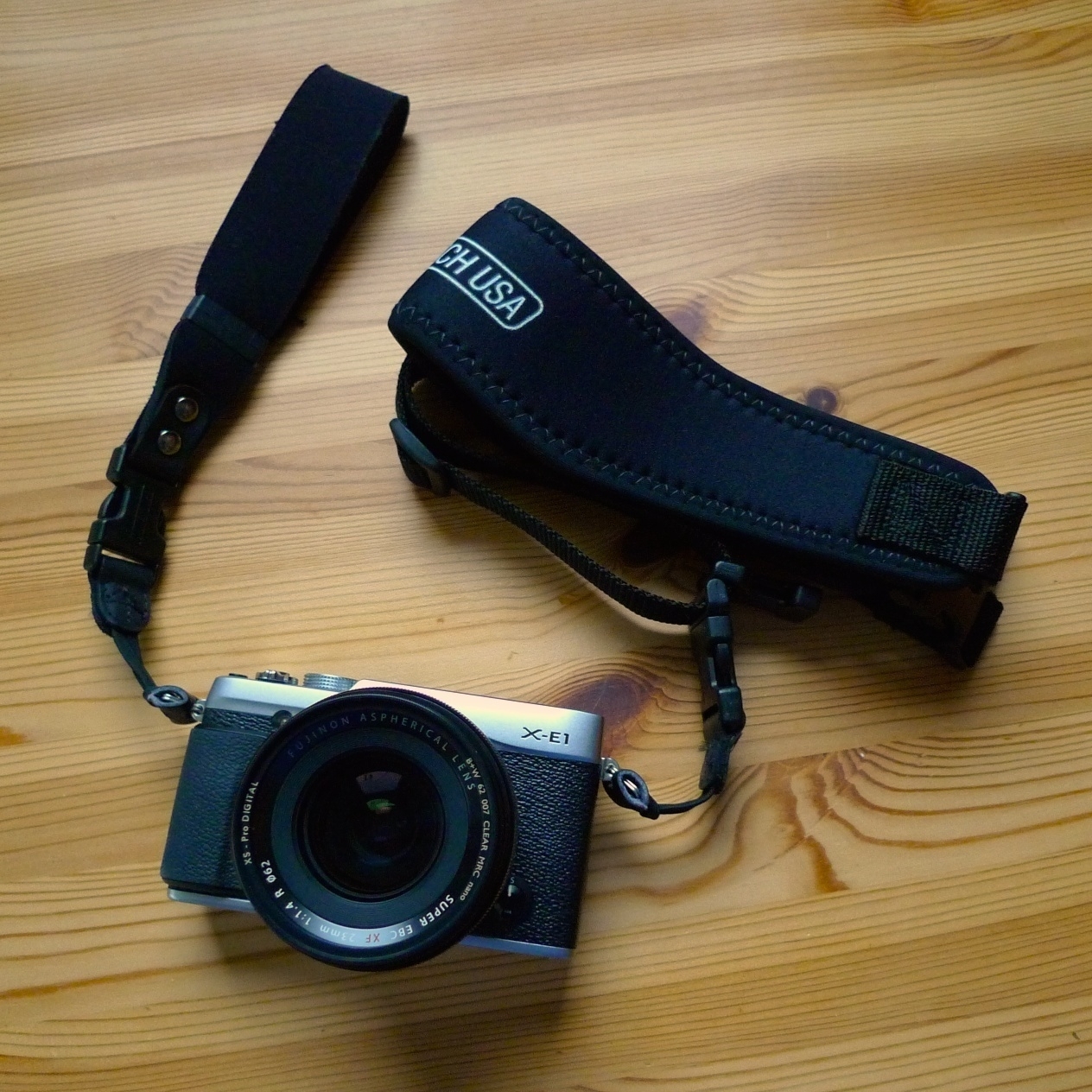
Someone in the movie industry must still think that 3D movies are a good idea and I think this person needs to be told to take a step back, then another step back, a few more steps back, leave the building and never come back again.
The most recent movie I watched in 3D was 'Captain America — The Winter Soldier'. Why did I watch it in 3D? Because it's not being shown in 2D and I wanted to see it in the cinema.
Or to put it another way: I was pretty much coerced into watching it in 3D because no cinema in the region shows the movie in 2D. To be allowed to pay to able to watch it in 2D, I was going to have to wait for the BluRay release.
Tell me how that makes sense? The movie industry is essentially telling me that I will love 3D even if they have to force me love it.
3D is nice in theory but there's only one movie I watched so far that did 3D "right" — in the sense that you can make 3D right and feel like something more than a novelty. That movie was 'The Hobbit'. It was filmed in 3D from start to finish and it's the only movie where 3D didn't feel like it was a tacked-on feature to get that badge on the movie poster.
The Hobbit was also best case scenario for 3D. Here the feature felt like a fun addition that didn't make me enjoy the movie more, but it also didn't diminish the movie watching experience.
Every other time that I watched a 3D movie in the cinema I was annoyed
With that in mind I decided that I won't watch 3D movies anymore. I wanted to watch the second Captain America movie because it ties into the recent Marvel releases and I like what they are doing here in terms of the story. Still, I'm not going to watch the 'Guardians of the Galaxy' movie in 3D, even though it, too, ties into Marvel's larger storyline. Luckily the latter is not the case with the new Spider-Man movie and the new X-Men movie or Godzilla. I'm not going to go and watch them in the cinema if they're not being shown in 2D, or any other movie for that matter.
So…
Dear cinemas, movie distributors, movie publishers, movie studios, movie studio executives,
I love going to the cinema. I love handing the cashier in the cinema my money. If the movie looks promising I even shell out the obscene € 10.- for some popcorn and a soft drink without hesitation.
I won't, however, watch any more 3D movies. They're just not worth it.
Cheers,
Alex
It's hard to overstate how important this issue is and how shamelessly the ISPs are lying to get what they want.
Need a better explanation? Watch this video by the always awesome CGP Grey below.
Found on: The Frogman
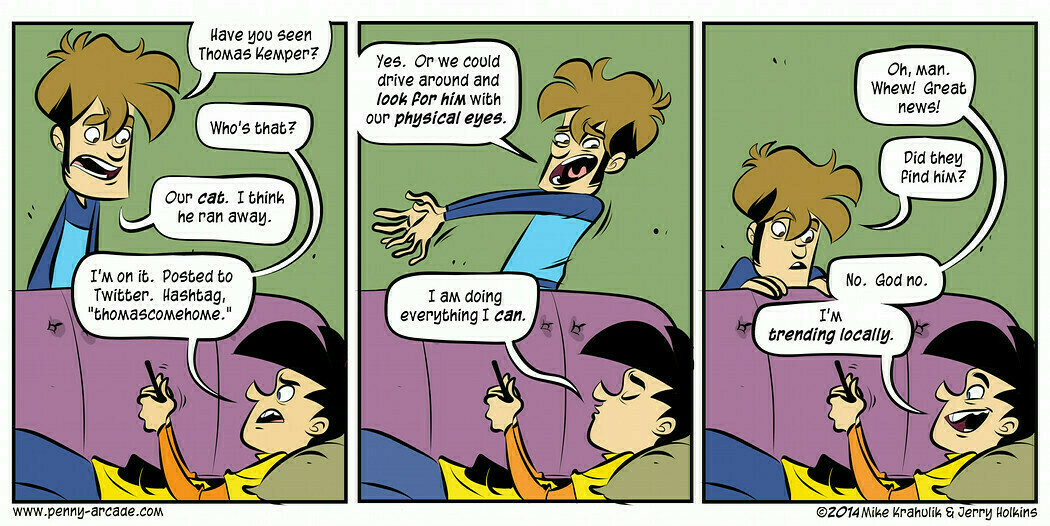
Source: Penny Arcade